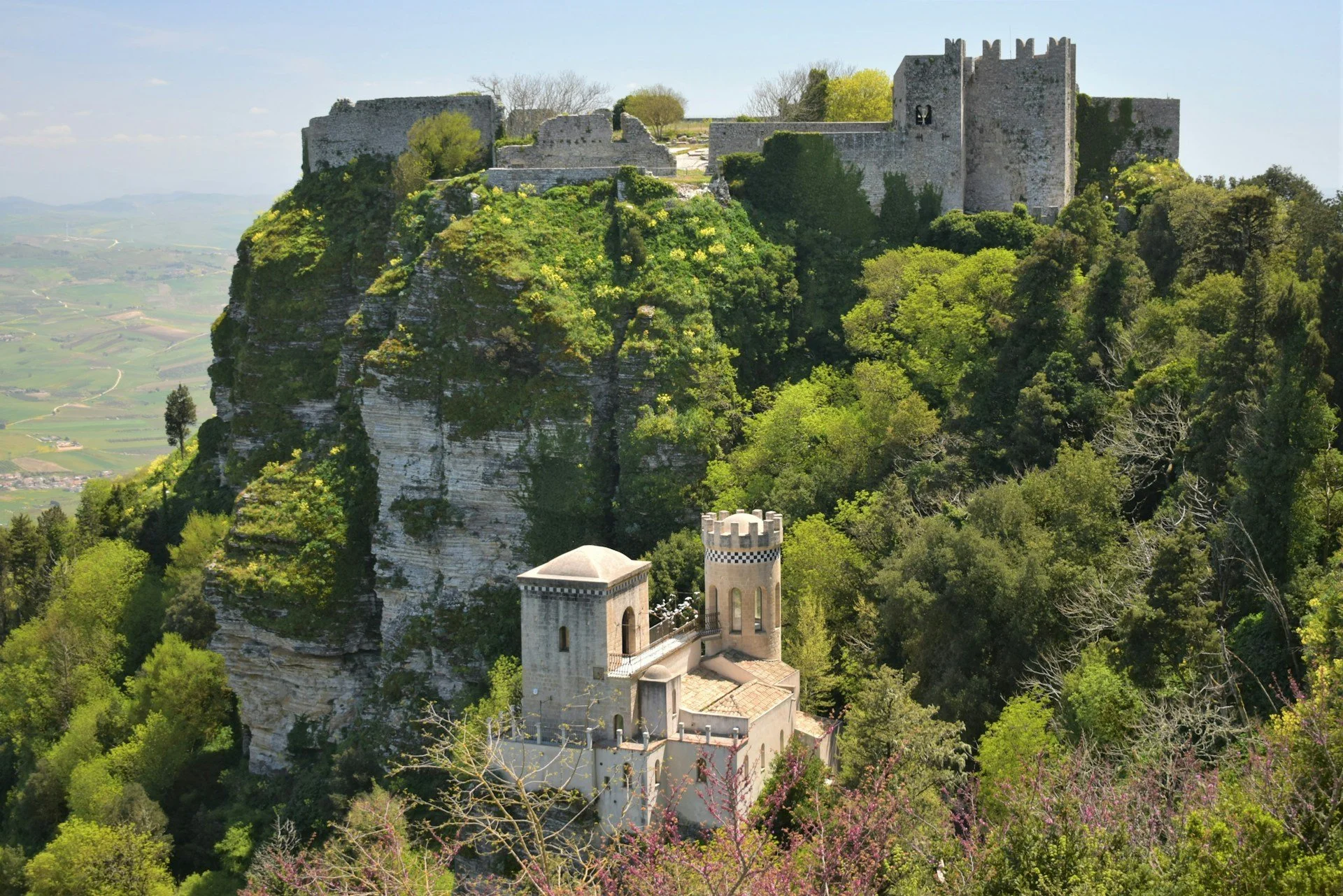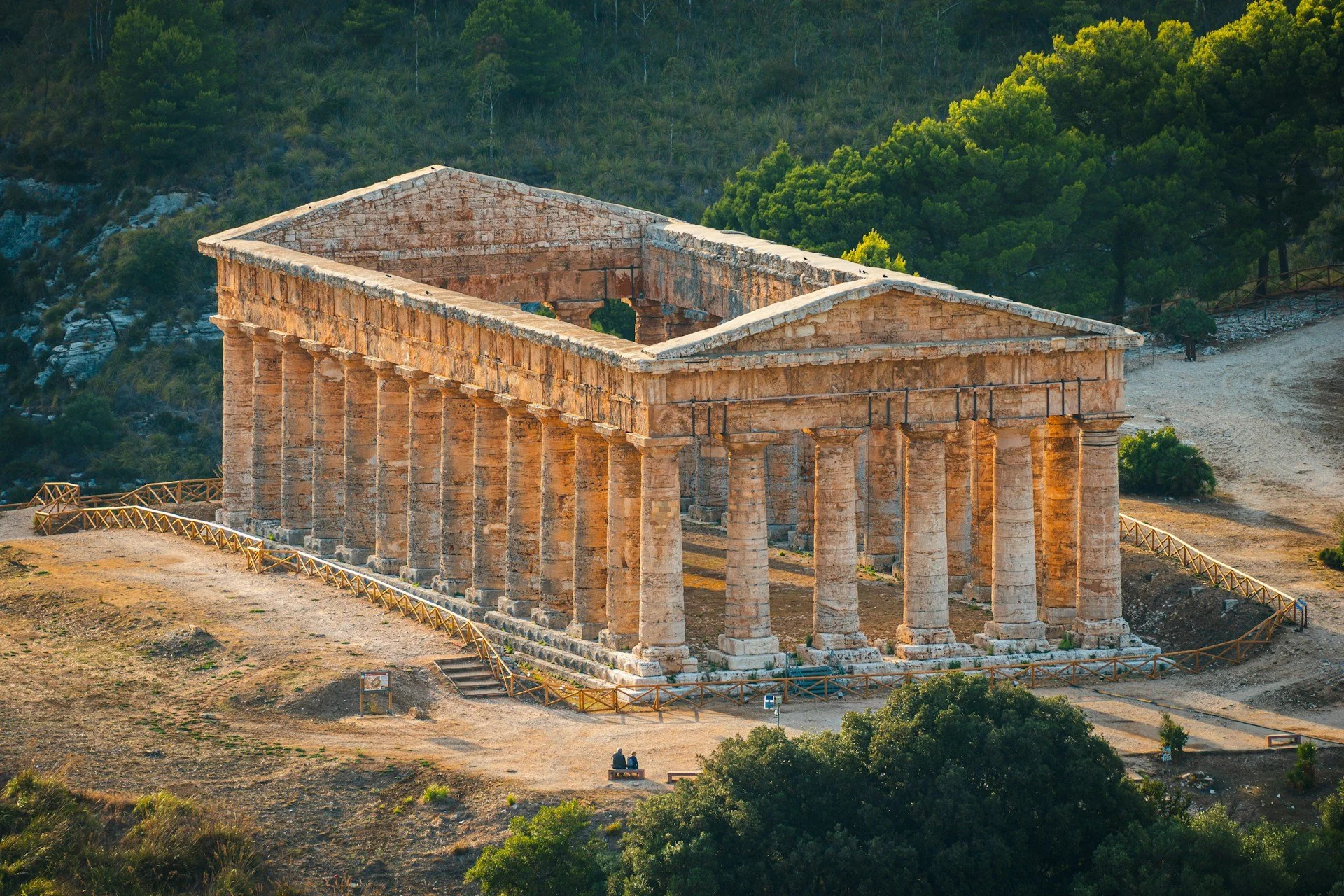4-day “Godfather” filming locations in Sicily tour
When most of us think of Sicily, the first thing that comes to mind is The Godfather trilogy—the holiest text for Mafia maniacs and mob movie buffs. Parts of each film and the 1969 book by Mario Puzo take place in the village of Sicily, the origin of the famous Italian-American family at the heart of the story, including in the village of Corleone. What some might not know is that Corleone is a real place, and that Francis Ford Coppola shot his iconic film adaptation on-location throughout the Italian island of Sicily. Since set jetting is booming, we’re going to make you an offer you can’t refuse: travel like a don with a private car and driver from Daytrip and see some of the real filming locations in person. Keep reading for a four-day “Godfather in Sicily” guide!
The Godfather filming locations in Sicily itinerary
Day 1: Palermo to Erice (Stops in: Cattedrale di Monreale)
Day 2: Erice to Corleone (Stops in: Segesta)
Day 3: Corleone to Taormina (Stops in: Castello Degli Schiavi)
Day 4: Taormina to Savoca (Stops in: Forza d’Agro)
Day 1: Palermo to Erice
Begin your Godfather tour in Palermo, the capital of Sicily. Named the Italian Capital of Culture in 2018, this ancient city is jam-packed with beautiful churches, galleries, and ancient buildings. It’s also the perfect place to gorge on Sicily’s famous cuisine. Treat yourself to pizza, cannoli, and arancini (deep-fried rice balls). And any trip to Italy would be incomplete without a scoop or two of the creamiest gelato. You can already visit some Godfather film locations right in Palermo. The late-19th century Massimo Theater is the third-largest opera theater in all of Europe. It’s also where Anthony performs in an opera, and Michael’s daughter dies on the staircase. Head just out of town to Villa Malfitano, a 19th-century rural palace with a vast and beautiful surrounding park. It is here that celebrations were held for Michael Corleone’s son, Anthony’s, debut as an opera singer in The Godfather Part III. When you’ve had your fill, head from Palermo to Erice to start you Godfather tour.
Cattedrale di Monreale
Spend 45 minutes at Sicily's finest example of Norman architecture, and one of the most beautiful Cathedrals in Italy. The UNESCO-listed Monreale Cathedral is decorated in Arabic and Byzantine styles and filled with an astounding 4,850 pounds (2,200 kg) of gold mosaics!
Arrival in Erice
High above western Sicily, Erice’s medieval fortress watches over the valley like a silent guardian. Photo by Tomasz Anusiewicz
Medieval Erice watches over the port of Trapani from its beautiful mountaintop position. Though small, it’s home to a whopping SIXTY churches! From Gothic Chiesa Madre to medieval Chiesa di San Giovanni Battista, there are some spectacular religious buildings dating as far back as the year 1074. For Godfather fans, the Baroque Chiesa di Sant’Orsola is the most important. The old church with its twin bells and vast courtyard appeared in The Godfather Part III as the entrance to the convent where Corleone meets Cardinal Lamberto. Along with the other 60 churches, Erice is home to two castles. Pepoli Castle from Saracen times and Castello di Venere from Norman times, are amongst the top sights in town and offer fabulous views of the Sicilian scenery.
Day 2: Erice to Corleone
After enjoying the amazing views and beautiful architecture, drive from Erice to Corleone, the real hometown of the fictional main family.
Segesta
Segesta’s well-preserved Doric temple stands mysteriously unfinished, echoing the ambitions of a long-lost Elymian city. Captured by Petr Slováček
The ruins of this ancient city are one of the most important archaeological sites in Sicily. They also appeared in the very first scenes in The Godfather Part III when the Corleone family is driving to Bagheria. Examine the 36 striking white columns of the Segesta Temple before heading further up the hill to the Greek Theatre. Partially carved into the mountain, it offers amazing views of the countryside and the temple.
Arrival in Corleone
Welcome to Corleone, where the infamous family has their roots! While Corleone plays a huge role in The Godfather epic, no filming was actually done here—director Francis Ford Coppola thought it had become too modern to reflect the era of the Godfather. However, thanks to the Hollywood classic, it’s a household name at the heart of so-called Mafia territory. What it lacks in screen presence it makes up for with the C.I.D.M.A Mafia Museum. Take a tour of the museum to hear the true story of the Mafia from past to present. A series of themed rooms educate visitors about Mafioso history; expect an informative view rather than the glorified movie version. Though small, the museum has a huge collection of documents and photographs that depict real-life Mafia memories of the Corleone area and beyond. Advance booking of tours and tickets are required.
Day 3: Corleone to Taormina
After getting your mafia education, head from Corleone to Taormina.
Castello Degli Schiavi
This beautiful Baroque country house appeared throughout the Godfather series. On film, the villa belonged to Don Tommasino. Spend 45 minutes at the villa where Michael Corleone taught Apollonia to drive, where her car got blown up, and where Michael eventually meets his own end. You’ll need to book your visit in advance, which we recommend for the chance to see the plush interior, complete with Godfather memorabilia!
Arrival in Taormina
The Teatro Antico di Taormina once hosted tragedies with volcano views, nature and drama on one stage. Photo by Federico Di Dio
While younger generations may now know Taormina better as the setting for The White Lotus season 2, This beautiful hillside town was perhaps the most influential Italian locale in the creation of the Godfather trilogy. Staff of the San Domenico Convent Hotel recommended the picturesque villages of Forza D’Agro and Savoca to Coppola, Taormina served as home base at the heart of the filming region, and in Part III saw its railway station stand in for that of Bagheria. Of course, The Godfather is just the tip of the iceberg in Taormina. Go to the ancient Greek Theatre, carved out of the rock on Mount Tauro, where on a clear day you can expect to see Mount Etna and the Ionian Sea in the distance. Stroll through the public gardens in Villa Comunale for unrivalled sea views, and for the best of all Sicilian views take a hiking trip to Mount Etna.
Day 4: Taormina to Savoca
When you’re ready, set out from Taormina to Savoca for the two most iconic Godfather film locations.
Forza d’Agro
The majority of Sicily you see in the Godfather trilogy was shot here in Forza d’Agro. The rugged natural landscape was the ideal setting to represent 1940’s Corleone. Today, it's still filled with traditional houses and cobbled streets watched over by a medieval fortress. Step right into scenes from The Godfather Part II with a visit to the Baroque Church of the Santissima Trinità in Piazza della Triade and the beautiful church of Maria Santissima Annunziata. Forza d'Agro is also one of few places to rival Taormina for its panoramic views.
Arrival in Savoca
Known for its Godfather fame, Savoca charms with misty hills, medieval churches, and sea-kissed silence. Photo by Andy Fluet
End your Godfather tour with the picturesque town that hosted some of the most recognizable scenes. Godfather fans flock here if just for a chance to visit Bar Vitelli. Located in the town’s charming main square, the vine-covered bar was the site of several major scenes in The Godfather Part I. It was here that Michael Corleone meets the owner of the bar, the father of his bride-to-be, and where Michael asks Apollonia’s father’s permission to marry her. It’s somewhat a shrine to The Godfather and a chance to be a part of legendary movie history. Just down the street, the Chiesa di San Nicolo is where Michael and Apollonia got married! Godfather aside, Savoca is a town worth visiting in its own right. This ancient hill village is a true taste of authentic Sicily, atmospheric with its old-world charm. Less touristy than neighbouring Taormina, it’s just far enough off the beaten track that you won’t be battling crowds.
Ready for your Godfather in Sicily tour?
Here’s each leg of our tour, so you can immerse yourself in Sicily’s rich culture, delicious food. And, of course, see the Godfather filming locations.
Palermo to Erice by car
Erice to Corleone by car
Corleone to Taormina by car
Taormina to Savoca by car





